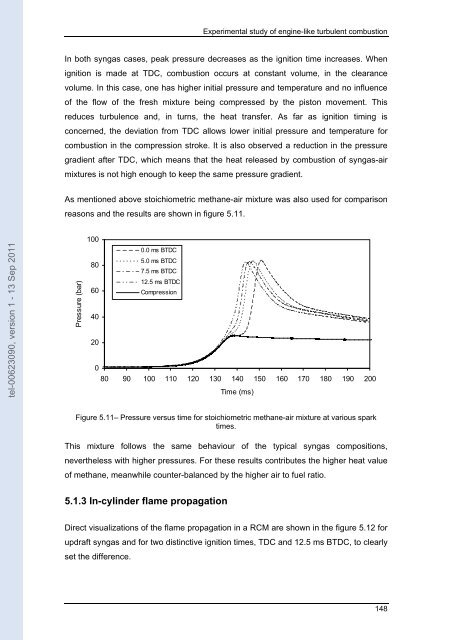Etude de la combustion de gaz de synthèse issus d'un processus de ...
Etude de la combustion de gaz de synthèse issus d'un processus de ...
Etude de la combustion de gaz de synthèse issus d'un processus de ...
Create successful ePaper yourself
Turn your PDF publications into a flip-book with our unique Google optimized e-Paper software.
Experimental study of engine-like turbulent <strong>combustion</strong><br />
In both syngas cases, peak pressure <strong>de</strong>creases as the ignition time increases. When<br />
ignition is ma<strong>de</strong> at TDC, <strong>combustion</strong> occurs at constant volume, in the clearance<br />
volume. In this case, one has higher initial pressure and temperature and no influence<br />
of the flow of the fresh mixture being compressed by the piston movement. This<br />
reduces turbulence and, in turns, the heat transfer. As far as ignition timing is<br />
concerned, the <strong>de</strong>viation from TDC allows lower initial pressure and temperature for<br />
<strong>combustion</strong> in the compression stroke. It is also observed a reduction in the pressure<br />
gradient after TDC, which means that the heat released by <strong>combustion</strong> of syngas-air<br />
mixtures is not high enough to keep the same pressure gradient.<br />
As mentioned above stoichiometric methane-air mixture was also used for comparison<br />
reasons and the results are shown in figure 5.11.<br />
tel-00623090, version 1 - 13 Sep 2011<br />
Pressure (bar)<br />
100<br />
0.0 ms BTDC<br />
5.0 ms BTDC<br />
80<br />
7.5 ms BTDC<br />
12.5 ms BTDC<br />
60<br />
Compression<br />
40<br />
20<br />
0<br />
80 90 100 110 120 130 140 150 160 170 180 190 200<br />
Time (ms)<br />
Figure 5.11– Pressure versus time for stoichiometric methane-air mixture at various spark<br />
times.<br />
This mixture follows the same behaviour of the typical syngas compositions,<br />
nevertheless with higher pressures. For these results contributes the higher heat value<br />
of methane, meanwhile counter-ba<strong>la</strong>nced by the higher air to fuel ratio.<br />
5.1.3 In-cylin<strong>de</strong>r f<strong>la</strong>me propagation<br />
Direct visualizations of the f<strong>la</strong>me propagation in a RCM are shown in the figure 5.12 for<br />
updraft syngas and for two distinctive ignition times, TDC and 12.5 ms BTDC, to clearly<br />
set the difference.<br />
148

















